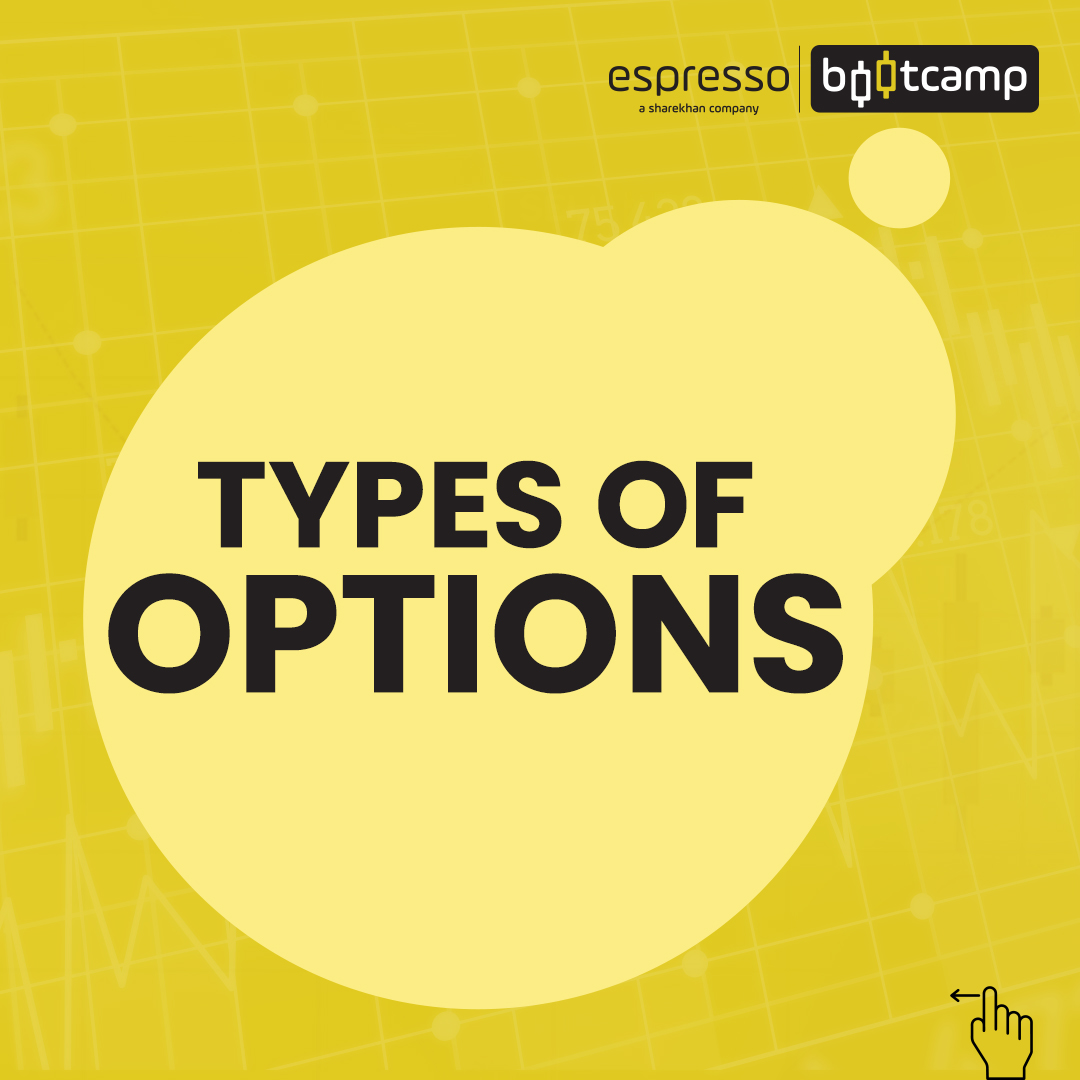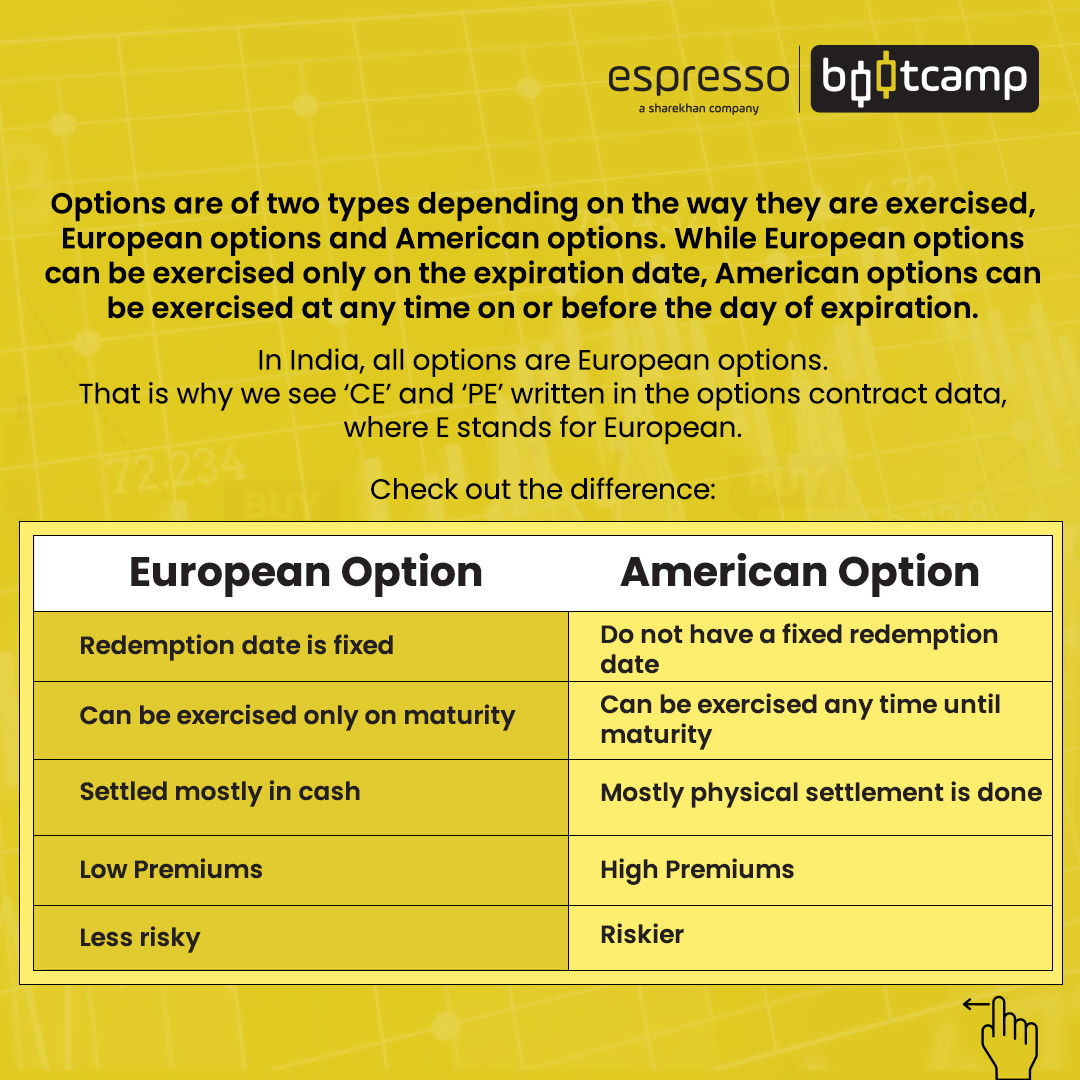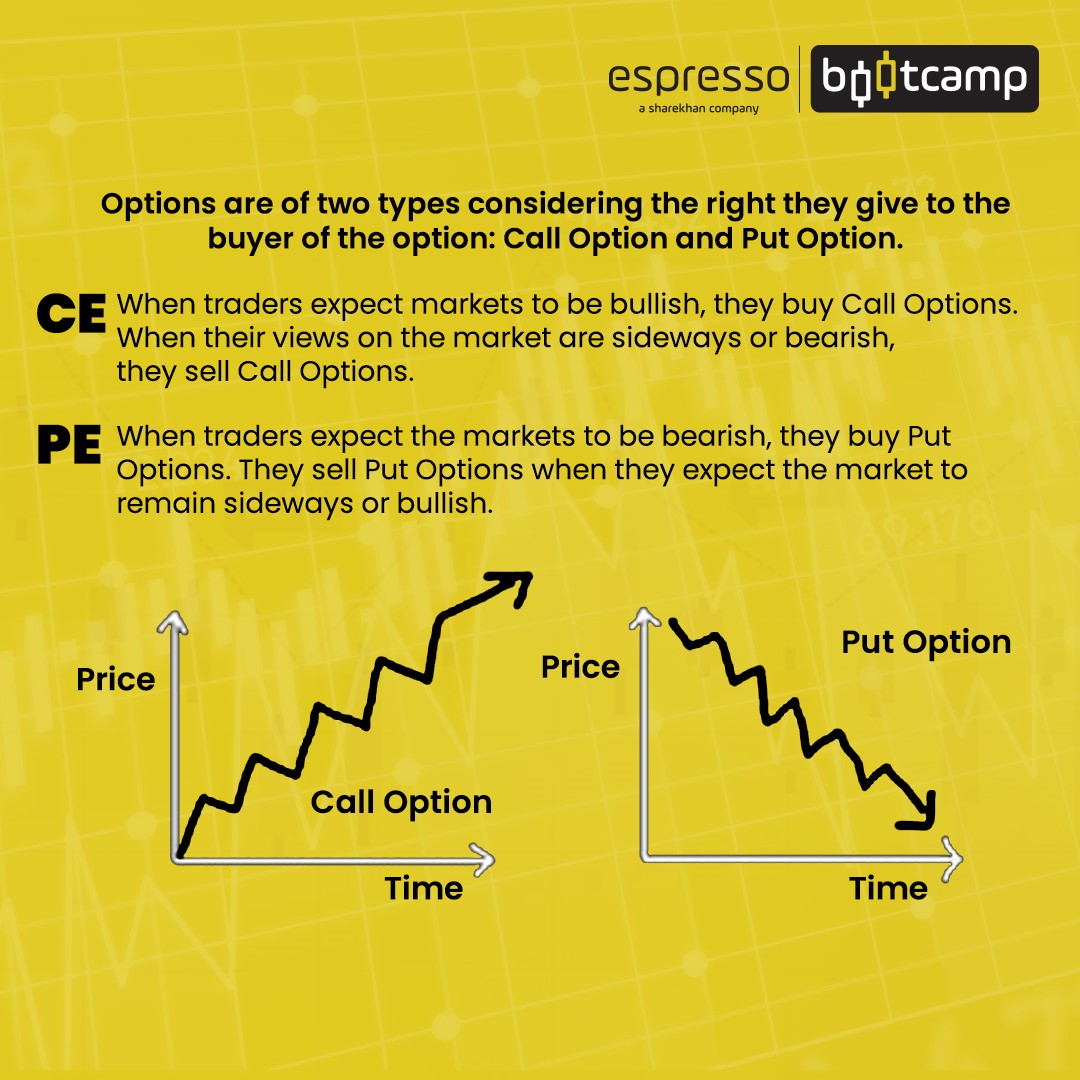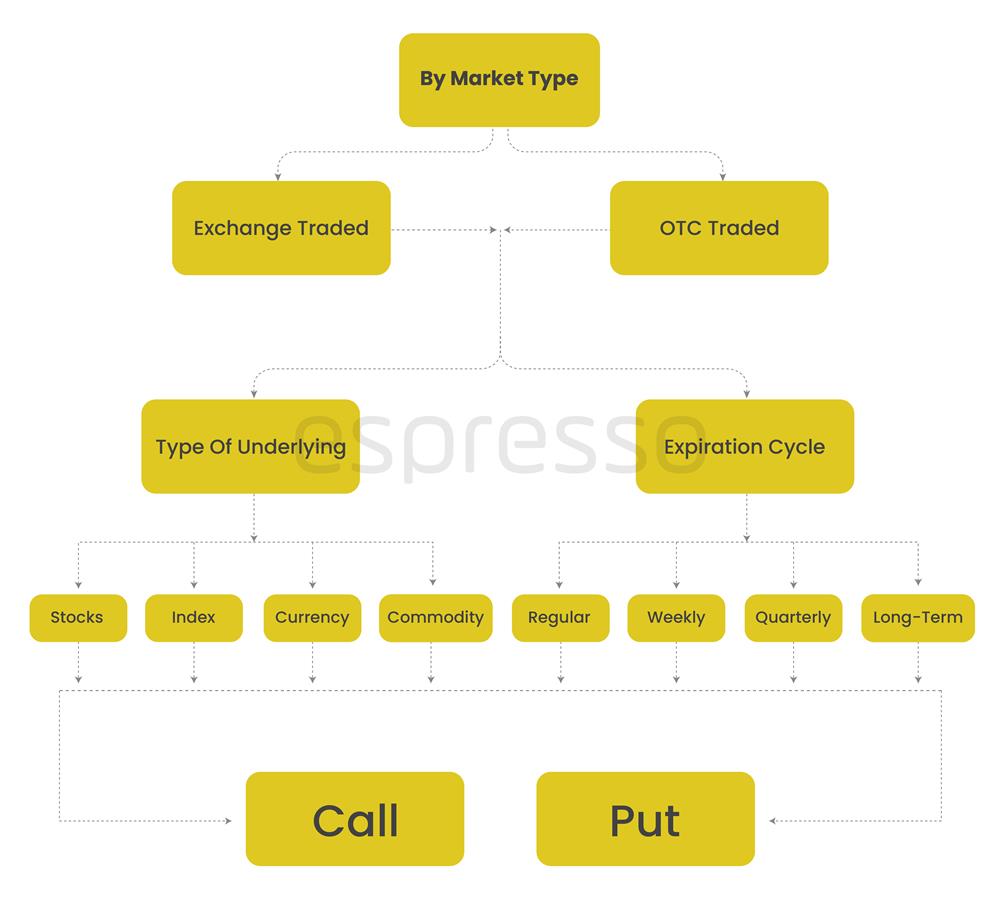Market sentiment can either be bearish or bullish. When the general price trend is upwards, it is bullish sentiment, and when prices, in general, are moving downwards, it is bearish sentiment. These two possibilities give rise to two option types, that is, call option and put option.



Thus, in a call option, the buyer of a call expects the price of the underlying to go up, while in the case of a put option, the buyer of the put expects the price of the underlying to go down. While a call option gives the buyer the right to buy (only the right and not the obligation), a put option gives the buyer the right to sell (and not the obligation).
When you have bought a call option expecting the price of the underlying to go up, and if the price indeed goes up, you can exercise your right and buy the underlying at the pre-determined price, which is the strike price, at any time on or before the expiry date. Alternatively, you can square off the option and pocket the premium difference (i.e., the difference in the call option premium at the time of purchase and at the time of sale).
On the other hand, having formed a pessimistic view about the trend, if you have bought a put option and if the price of the underlying goes down, you can exercise your right and sell the underlying at the pre-determined price, which is the strike price, at any time on or before the expiry date. Here also, instead of selling the underlying, you can square off the put option and pocket the premium difference.

But remember, you will make a profit only if the price moves in the same direction as you have predicted, which may not happen always. If the price doesn’t move in the direction you had anticipated but moves in the opposite direction, instead of earning a profit, you may incur a loss. But the maximum loss which you might incur is limited to the premium you have paid on the option contract, nothing more than that. Thus, if you have bought a call option and the price of the underlying falls, you can either square off your contract (before the expiry) or simply let it expire on the expiry date without squaring off the option. In the case of the first option, you may perhaps save something on the premium, while in the second case, you may lose the entire premium you have paid while buying the option contract. Nevertheless, you need not pay anything more than the amount you had originally paid while entering into the contract. The same rule applies while buying the put option too.
There are also various options types in share market based on the market type, type of underlying or expiration period. Classification of options based on the type of the underlying is as follows:
Stock Options: This has nothing to do with the employee stock option plan (ESOP); it’s all about stocks in which options trading is allowed. On the National Stock Exchange of India, about 175 publically-listed companies are allowed as underlying security for options trading. Stocks for derivatives trading (including options trading) are selected from among the top 500 stocks based on their average daily market capitalization and average daily traded value in the previous six months on a rolling basis. In other words, the stocks selected for the F&O segment will remain in that segment as long as they satisfy the selection criteria.
Index Options: Even popular indices can be used as underlying for options trading. Index Options are more popular option types than stock options on the NSE. Currently, options trading is available in Nifty 50, Nifty Bank, Nifty Financial and Nifty Midcap on the NSE. Smaller lot sizes, lower margin requirements, and higher liquidity are the main attractions of trading in index options. Institutions also use index options for hedging purposes.
Currency Options: These option types are also known as Forex Options. Though there are rupee pairs and cross-currency pairs in currency options in India, on the NSE, rupee-denominated pairs are more popular as non-rupee-denominated currency pairs lack liquidity. These are mostly used by banks and those who have foreign currency transactions, like exporters, importers and borrowers in foreign currencies.
Commodity Options: Though commodity options, too, operate on similar lines as equity options, in the case of commodity options, they are allowed on futures and not spots. Options on commodities are of recent origin and are yet to gain popularity among traders and investors.
Classification based on market type: Based on the market type, options types can be classified into exchange-traded options and OTC-traded options.
Exchange-traded options: These are the most common and formal types of options. Since these are traded on exchanges, they are formal and governed by the rules and regulations prescribed by the Securities and Exchange Board of India. Hence, they are safer as the execution of the contracts is ensured.
OTC-traded options: Over-The-Counter (OTC) options are usually based on personal contacts and, so, are rather informal. Since these are traded only in the OTC markets, they are less accessible to the general public. They are usually customized contracts with more complicated terms than most exchange-traded contracts and are more popular in currency transactions. Stock options are not traded in the OTC in India.
Classification based on expiration cycle: Every story has an end, so do derivative contracts. The last date of the derivative contract is the expiration date. A trader has to settle his contract on or before the expiration date. Classifications of options based on the expiration cycle are:
Regular options: These are based on the standardized expiration cycles that options contracts are listed under. Different exchanges have different expiration cycles. For example, on the Nasdaq, at any given point in time, a basic option has contracts with three expiration dates outstanding. Similarly, on the NSE, at any point in time, there are three contracts available for trading, i.e., one near-month (NEAR), one next-month (NEXT) and one third-month (FAR) duration. They expire on the last Thursday of the expiration month.
Weekly options: Weekly options made a late entry into the Indian stock exchanges. Weekly expiry was introduced in Bank Nifty in 2016, while weekly options in Nifty 50 were made available in 2019. Though the basic principle of weekly options is the same as regular options, they just have a much shorter expiration period. Lately, they have been gaining popularity.
Quarterly options: Though not available for stocks in India, the trader, in this case, can choose any expiration cycle between the nearest four quarters plus the final quarter of the following year.
Long-Term Expiration Anticipation Securities: These contracts have expiration dates that extend beyond one year and up to three years. These are mainly used by institutional investors to hedge long-term holdings.
Sample Table showing volume of trade on NSE
| Product | Volume (Shares/Contracts) |
Traded Value Rs in Cr |
| Equities | 2,32,39,05,304 | 57,593.17 |
| Index Futures | 3,26,393 | 29,769.23 |
| Index Options | 9,48,68,447 | 34,762.10 |
| Vol Futures | - | - |
| Stock Futures | 7,34,372 | 52,622.99 |
| Stock Options | 30,03,208 | 3,957.69 |
| Global Indices Futures | - | - |
| Global Indices Options | - | - |
| Currency Futures | 34,68,865 | 27,852.46 |
| Currency Options | 1,09,70,033 | 160.25 |
| NSE Bond Futures | 368 | 6.77 |
| Commodity Futures | 1 | 0.05 |
(Figures given above are as of 8/8/2022 on National Stock Exchange)
From the above table, it is clear that the Index Option is the most popular product on the Indian stock exchanges. Between the stock futures and stock options, it’s the latter that is more popular, as indicated by the higher number of contracts.
Things to remember
- The two general trends in the market are Bullish sentiment and Bearish sentiment. The two option types i.e. Call options and Put options have been developed to trade and make profits in these phases.
- The buyer of a call option expects the price of the underlying to go up. Vice versa for a put option.
- A call option gives the buyer the right to buy (and not the obligation), and a put option gives him the right to sell (and not the obligation).
- Index Option is the most popular product on the Indian stock exchanges.
- Also, between stock futures and stock options, it’s the latter that is more popular among traders and investors.
 0
|
0
|
 0
0
 Modules
Modules

 Watch
Watch 
